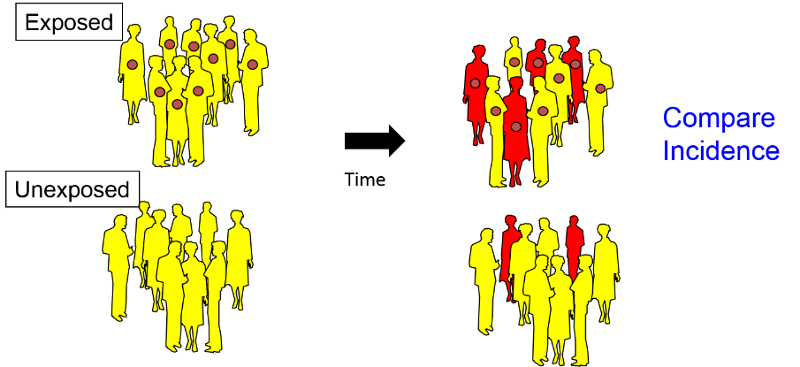Cohort Studies
Key Features of Cohort Studies
In cohort studies investigators enroll individuals who do not yet have the health outcomes of interest at the beginning of the observation period, and they assess exposure status for a variety of potentially relevant exposures. The enrollees are then followed forward in time (i.e., these are longitudinal studies rather than cross-sectional) and health outcomes are recorded. With this data investigators can sort the subjects according to their exposure status for one of the exposures of interest and compare the incidence of disease among the exposure categories.

For example, in 1948 the Framingham Heart Study enrolled a cohort of 5,209 residents of Framingham, MA who were between the ages of 30-62 and who did not have cardiovascular disease when they were enrolled. These subjects differed from one another in many ways: whether they smoked, how much they smoked, body mass index, eating habits, exercise habits, sex, family history of heart disease, etc. The researchers assessed these and many other characteristics or "exposures" soon after the subjects had been enrolled and before any of them had developed cardiovascular disease. The many "baseline characteristics" were assessed in a number of ways including questionnaires, physical exams, laboratory tests, and imaging studies (e.g., x-rays). They then began "following" the cohort, meaning that they kept in contact with the subjects by phone, mail, or clinic visits in order to determine if and when any of the subjects developed any of the "outcomes of interest," such as myocardial infarction (heart attack), angina, congestive heart failure, stroke, diabetes and many other cardiovascular outcomes. They also kept track of whether their risk factors changed.
Over time some subjects eventually began to develop some of the outcomes of interest. Having followed the cohort in this fashion, it was eventually possible to use the information collected to evaluate many hypotheses about what characteristics were associated with an increased risk of heart disease. For example, if one hypothesized that smoking increased the risk of heart attacks, the subjects in the cohort could be sorted based on their smoking habits, and one could compare the subset of the cohort that smoked to the subset who had never smoked. For each such comparison that one wanted to make, the cohort could be grouped according to whether they had a given exposure or not, and one could measure and compare the frequency of heart attacks (i.e., the cumulative incidence or the incidence rates) between the groups.
The Population "At Risk"
From the discussion above, it should be obvious that one of the basic requirements of a cohort type study is that none of the subjects have the outcome of interest at the beginning of the follow-up period, and time must pass in order to determine the frequency of developing the outcome.
For example, if one wanted to compare the risk of developing uterine cancer between postmenopausal women receiving hormone-replacement therapy and those not receiving hormones, one would consider certain eligibility criteria for the members prior to the start of the study: 1) they should be female, 2) they should be post-menopausal, and 3) they should have a uterus. Among post-menopausal women there might be a number who had had a hysterectomy already, perhaps for persistent bleeding problems or endometriosis or prior uterine cancer. Since these women no longer have a uterus, one would want to exclude them from the cohort, because they are no longer at risk of developing this particular type of cancer. Similarly, if one wanted to compare the risk of developing diabetes among nursing home residents who exercised and those who did not, it would be important to test the subjects for diabetes at the beginning of the follow-up period in order to exclude all subjects who already had diabetes and therefore were not "at risk" of developing diabetes.


